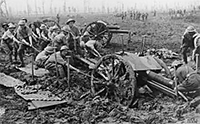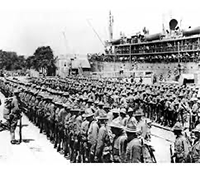World War I
Part 5: 1917
At the same time, the United States joined the fighting. The U.S. had supplied the Allied forces with a large amount of money and weapons but had not, for the first three years of the war, officially declared war on the Central Powers. That changed in April 1917, and waves of American troops bolstered the Allied defense in the West. By the end of the year, more than 2 million American soldiers had gone ashore. Commanding the American Expeditionary Force was General John J. Pershing. It took some time for American commanders to coordinate with French and U.K. military leaders, however. 
A main focus for the Western armies in early 1917 was in the northwest. Members of the British Expeditionary Force (BEF) had been in the Ypres area since the beginning of the war. The Battle of Passchendaele, also known as the Third Battle of Ypres, was a tactical victory for Allied troops, as they regained control of the Belgian town of Passchendaele in July; however, casualties on both sides were very high. The Allied advance continued, piercing the vaunted Hindenburg Line and pushing the German forces further and further back. One of those Allied victories came at Cambrai, one of the first uses of a mass tank attack in military history. Maritime conflicts: 1917
In the Near East: 1917
Aerial conflicts: 1917
Still flying this late in the war were the Zeppelins, German airships that had begun the war strafing cities in Belgium, France, and the U.K. |
|
Social Studies for Kids
copyright 2002–2025
David White



 Dominating the first half of 1917 were the withdrawal of one major power from the war and the entry of another. The Russian Revolution brought about huge change in the country, not the least of which was a move away from fighting in the Great War. The last Russian attack of the war was the Kerensky Offensive, which was a failure. The eventual result was the surrender of large amounts of territory to Germany, but the people of Russia were more interested in things domestic and so Russia left the war.
Dominating the first half of 1917 were the withdrawal of one major power from the war and the entry of another. The Russian Revolution brought about huge change in the country, not the least of which was a move away from fighting in the Great War. The last Russian attack of the war was the Kerensky Offensive, which was a failure. The eventual result was the surrender of large amounts of territory to Germany, but the people of Russia were more interested in things domestic and so Russia left the war.
